Why Penang’s economic future still lies in manufacturing and not the services sector.
Fifteen years or so ago, Malaysia’s Second Industrial Master Plan introduced the strategy of “manufacturing plus-plus” which was fondly described as the smiling-curve. This is the shape of the value chain diagram with value added on the vertical axis and the chain of activities required to put a product on the market along the horizontal axis. Fabrication and assembly, which make up the bulk of Malaysia’s manufacturing activities in these past decades, fall in the middle of the value chain and therefore are at the lowest points in terms of value added. Plus-plus, as the strategy goes, is to move away from manufacturing activities at the middle of the smiling-curve - and upstream into R&D and design, and downstream into marketing and distribution.
In recent years however, there is talk of moving out of manufacturing and into services because the global financial crisis has reduced the demand for exports, and services alone now comprise at least half of Malaysia’s gross domestic product or GDP. Has Malaysia truly become a tertiary stage services economy, after evolving from a primary stage economy in the 1950s and 1960s to a manufacturing based economy in the 1970s?
The evolution of the country’s economy is of great importance to Penang, as the state has played a significant role in the country’s economic history. The island was the country’s first postindustrial port through which commodities from the mainland were semi-processed and then shipped abroad during colonial times. Much later, when Malaysia was a young nation barely in its teens, Penang began export-driven manufacturing even before words like globalisation, outsourcing, competitive advantage, just-in-time manufacturing, computer numerical control (CNC) machines and so on were coined. Official statistics continue to show that Penang’s economy is still driven by manufacturing, suggesting that the state is not evolving into services in the same way as the national economy.
Where is Penang’s economy heading and what policies and actions are needed to set the course for the state’s future? How does one decide if its economy will be driven by services or the manufacturing sector?


